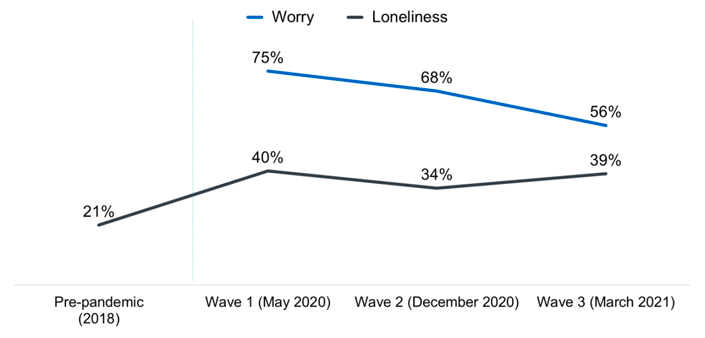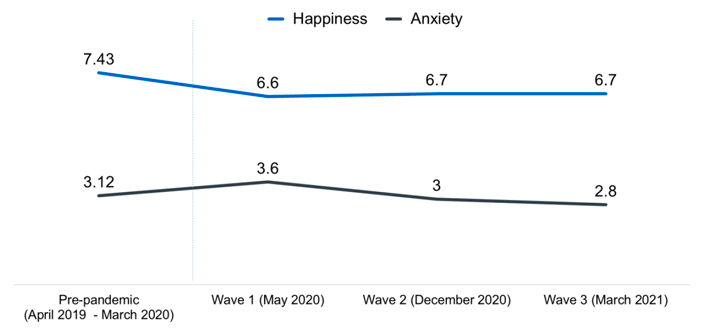Coronavirus (COVID-19) impact on wellbeing: wave 3 - survey summary
Findings from the final wave of a telephone survey we commissioned to better understand the impact of the COVID-19 pandemic on people in Scotland.
This document is part of a collection
1. Impact on Wellbeing
Respondents were asked about whether they had experienced loneliness, what they were worried or concerned about and their levels of happiness and anxiety.
Loneliness was recorded as a percentage who agreed they were lonely 'some', 'most' or 'all' of the time in the last week.[8] Worry was recorded as a percentage who reported they were worried about family or friends becoming ill with COVID-19.[9] Happiness and anxiety were measured on a scale of 0 to 10, where 0 is 'not at all' and 10 is 'completely'. Pre-pandemic measures are taken from the Office of National Statistics (ONS) Scottish estimates.[10]
Overview of changes:
Loneliness:
- In March 2021, around four in ten (39%) felt lonely at least some of the time in the past week, with 4% feeling lonely 'all' or 'almost all' of the time. The overall proportion experiencing loneliness is almost twice as high as it was in 2018 (21%).
Worry:
- Worrying about family and friends becoming seriously ill with COVID-19 was the most common concern reported across all three waves. However, worry fell since the start of the pandemic (from 75% in May 2020 to 56% in March 2021). Concern about other's mental health changed less between waves (with between 41% and 48% concerned).
Happiness:
- Across all three waves, the average happiness score has remained stable at 6.6/6.7 out of 10. However, it is lower than the ONS pre-pandemic figure (7.43).
Anxiety:
- During the first lockdown, in May 2020, the mean anxiety score increased compared to the ONS pre-pandemic figure. It then decreased, from 3.6 to 2.8 out of 10. In March 2021, it was lower than the ONS pre-pandemic figure.

From May 2020 to March 2021, levels of loneliness have remained high. It is encouraging to see that levels of worry about others becoming ill with Coronavirus have decreased over time, from May 2020 to March 2021.

Mean levels of happiness have remained relatively high and stable across the three survey waves. After initially rising in lockdown one (May 2020), mean levels of anxiety have decreased over time, meaning people reported feeling less anxious.
The pandemic typically had a more negative effect, by the measures included, on certain groups, including: women, younger people, people with lower household incomes, people living alone and disabled people.
Focus on different groups (Data from Wave 3/March 2021)
Gender
Women reported higher levels of anxiety than men. Men reported higher levels of happiness than women.
Loneliness was slightly higher in women than men.
Women were most worried about friends and family members becoming seriously ill.
Age
Younger people reported higher levels of anxiety and loneliness and were more likely to be worried about mental health and finances.
Older people (over 55) reported higher levels of happiness. The biggest decrease in anxiety scores from wave 2 to 3 was among those aged 70 plus.[11]
Household income
Those on lower incomes reported higher levels of anxiety and loneliness than those on higher incomes.
Living situation
Respondents who lived alone reported higher levels of anxiety and loneliness.
Disability
Disabled respondents reported higher levels of anxiety and loneliness.
Contact
Email: covid-19.behaviours@gov.scot
There is a problem
Thanks for your feedback